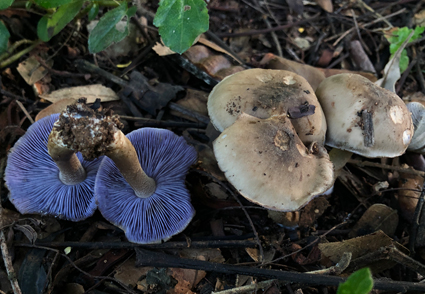Abstract
Asproinocybe hongyaniae, a new species discovered in northern Thailand, is described, illustrated, and compared with phylogenetically related and morphologically similar species. This new species is characterized by the medium grey to olive grey pileus, light violet to violet blue lamellae, oblong and colourless basidiospores (5.8–8.5 × 4.5–6.3 μm), narrowly clavate pleurocystidia and cheilocystidia. Molecular analyses employing the internal transcribed spacer (ITS) and large subunit (nrLSU) of nuclear ribosomal DNA sequences strongly supported the new species. An updated key is also provided to assist in identifying all ten Asproinocybe species in the genus. The genus Asproinocybe is the first report in Thailand.
References
- Alvarado, P., Moreno, G., Vizzini, A., Consiglio, G., Manjón, J.L. & Setti, L. (2015) Atractosporocybe, Leucocybe and Rhizocybe: three new clitocyboid genera in the Tricholomatoid clade (Agaricales) with notes on Clitocybe and Lepista. Mycologia 107 (1): 123–136. https://doi.org/10.3852/13-369
- Angelini, P., Arcangeli, A., Bistocchi, G., Venanzoni, R. & Rubini, A. (2017) Tricholosporum goniospermum, genetic diversity and phylogenetic relationship with the Tricholomatineae. Sydowia 69: 9–18.
- Capella-Gutiérrez, S., Silla-Martínez, J.M. & Gabaldón, T. (2009) trimAl: a tool for automated alignment trimming in large-scale phylogenetic analyses. Bioinformatics 25 (15): 1972–1973. https://doi.org/10.1093/bioinformatics/btp348
- Guzmán, G., Montoya, L. & Bandala, V.M. (1990) Observations on the genera Asproinocybe and Tricholosporum, and description of a new species of Tricholosporum (Agaricales, Tricholomataceae). Mycotaxon 38: 485–495.
- Guzmán, G., Ramirez-Guillen, F., Contu, M., Rodriguez, O. & Guzmán-Davalos, L. (2004) New records of Asproinocybe and Tricholosporum (Agaricales, Tricholomatacées). Documents Mycologiques 33 (131): 23–28.
- Heim, R. (1969) Cahiers de la Maboké. Vol. 7 (2). Laboratoire de Cryptogamie du Museum National d’Histoire Naturelle: Paris, France, pp. 83–85.
- Heim, R. (1970) Breves diagnoses latinae novitatum genericarum specificarumque nuper descriptarum. Revue de Mycologie (Paris) 34 (4): 343–347.
- Heinemann, P. (1976) Un nouvel Asproinocybe (Tricholomataceae) du Zaïre. Bulletin du Jardin Botanique National de Belgique 47 (1–2): 265–265. https://doi.org/10.2307/3668001
- Hall, T. (2007) BioEdit v7. [http://www.mbio.ncsu.edu/BioEdit/BioEdit.html]
- Kornerup, A. & Wanscher, J.H. (1967) Methuen Handbook of Colour. Methuen and Co., London.
- Katoh, K. & Standley, D.M. (2013) MAFFT multiple sequence alignment software version 7: improvements in performance and usability. Molecular Biology and Evolution 30 (4): 772–780. https://doi.org/10.1093/molbev/mst010
- Kumar, J. & Atri, N.S. (2021) Characterisation and identification of ectomycorrhizae formed by the species of Asproinocybe (Tricholomataceae) and Inocybe (Inocybaceae) with the roots of the tropical sal tree Shorea robusta (Dipterocarpaceae). Ukrainian Botanical Journal 78: 112–122. https://doi.org/10.15407/ukrbotj78.02.112
- Liu, Y.C., Liu, P., Hu, H.P., Li, D. & Li, Y. (2016) Tricholosporum, a newly recorded genus of Agaricomycetes in China. Phytotaxa 289 (3): 263–270. https://doi.org/10.11646/phytotaxa.289.3.6
- Lebel, T., Syme, K., Barrett, M.D. & Cooper, J.A. (2020) Two new species of Asproinocybe (Tricholomataceae) from Australasia. Muelleria 38: 77–85. https://doi.org/10.5962/p.337581
- Matheny, P.B., Curtis, J.M., Hofstetter, V., Aime, M.C., Moncalvo, J.M., Ge, Z.W., Yang, Z.L., Slot, J.C., Ammirati, J.F., Baroni, T.J., Bougher, N.L., Hughes, K.W., Lodge, D.J., Kerrigan, R.W., Seidl, M.T., Aanen, D.K., DeNitis, M., Daniele, G.M., Desjardin, D.E., Kropp, B.R., Norvell, L.L., Parker, A., Vellinga, E.C., Vilgalys, R. & Hibbett, D.S. (2006) Major clades of Agaricales: A multilocus phylogenetic overview. Mycologia 98: 982–995. https://doi.org/10.1080/15572536.2006.11832627
- Miller, M.A., Pfeiffer, W. & Schwartz, T. (2010) Creating the CIPRES Science Gateway for inference of large phylogenetic trees. In: 2010 gateway computing environments workshop (GCE). pp. 1–8. https://doi.org/10.1109/GCE.2010.5676129
- Mou, G.F. & Bau, T. (2021) Asproinocybaceae fam. nov. (Agaricales, Agaricomycetes) for Accommodating the genera Asproinocybe and Tricholosporum, and description of Asproinocybe sinensis and Tricholosporum guangxiense sp. nov. Journal of Fungi 7 (12): 1086. https://doi.org/10.3390/jof7121086
- Nilsson, R.H., Ryberg, M., Kristiansson, E., Abarenkov, K., Larsson, K.H. & Kõljalg, U. (2006) Taxonomic reliability of DNA sequences in public sequence databases: a fungal perspective. PloS One 1 (1): e59. https://doi.org/10.1371/journal.pone.0000059
- Petersen, J.H. (2001) Asproinocybe a beautiful surprise. [http://www.mycokey.com/AAU/WestAfrica/Asproinocybe.htm]
- Ronquist, F., Teslenko, M., Van der Mark, P., Ayres, D.L., Darling, A., Höhna, S., Larget, B., Liu, L., Suchard, M.A. & Huelsenbeck, J.P. (2012) MrBayes 3.2: Efficient Bayesian phylogenetic inference and model choice across a large model space. Systematic Biology 61 (3): 539–542. https://doi.org/10.1093/sysbio/sys029
- Ralaiveloarisoa, A.B., Liimatainen, K., Ralimanana, H., Jeannoda, V., Cable, S. & Niskanen, T. (2020) Two new species of Hygroaster from Madagascar. Mycological Progress 19 (11): 1293–1300. https://doi.org/10.1007/s11557-020-01626-z
- Seeloy-ounkeaw, T., Khamyong, S. & Anongrak, N. (2012) Ecosystem water storages of conservation and utilization community forests of Karen tribe, Chiang Mai, northern Thailand. In A paper presented in the 1st Mae Fah Luang University International Conference, Chiang Rai province.
- Stamatakis, A. (2014) RAxML version 8: a tool for phylogenetic analysis and post-analysis of large phylogenies. Bioinformatics 30 (9): 1312–1313. https://doi.org/10.1093/bioinformatics/btu033
- Thoen, D. (1977) Asproinocybe brunneolilacina Thoen, une nouvelle espèce d'Agaricale du Zaïre. Bulletin du Jardin Botanique National de Belgique 47 (1–2): 53–54. https://doi.org/10.2307/3667981
- Vilgalys, R. & Hester, M. (1990) Rapid genetic identification and mapping of enzymatically amplified ribosomal DNA from several Cryptococcus species. Journal of Bacteriology 172 (8): 4238–4246. https://doi.org/10.1128/jb.172.8.4238-4246.1990
- Vizzini, A., Consiglio, G., Marchetti, M. & Alvarado, P. (2020) Insights into the Tricholomatineae (Agaricales, Agaricomycetes): A new arrangement of Biannulariaceae and Callistosporium, Callistosporiaceae fam. nov., Xerophorus stat. nov., and Pleurocollybia incorporated into Callistosporium. Fungal Diversity 101: 211–259. https://doi.org/10.1007/s13225-020-00441-x
- Watling, R. (1997) Tricholosporum superbum: a new Malesian agaric. Bollettino del Gruppo Micologico G. Breasadola 40: 485–490.
- White, T.J., Bruns, T., Lee, S.J.W.T. & Taylor, J. (1990) Amplification and direct sequencing of fungal ribosomal RNA genes for phylogenetics. PCR protocols: a guide to methods and applications 18 (1): 315–322. https://doi.org/10.1016/B978-0-12-372180-8.50042-1


